In the world of music production, the microphone is more than just a tool 一 it’s a gateway to capturing sonic excellence.
Micrphones can help you capture the intricacies of a performance, convey the mood of a track, and ensure clarity.
Every sound, whether it’s the timbre of an instrument or the raw emotion of vocals, requires a specific type of microphone to be captured perfectly.
Knowing the different types of microphones and their applications can elevate the quality of your recordings and help you realize your artistic vision.
That is why, in today’s article, we’ll be breaking down:
- Different types of microphones and why they matter ✓
- The role of sound quality in your mix ✓
- Differences and benefits of Condenser mics & Dynamic mics ✓
- The unique characteristics of Ribbon mics ✓
- Cardioid mics and their directional advantages ✓
- Modern trends with USB microphones ✓
- Specialty microphones for specific recording needs ✓
- Practical techniques to enhance sound capture ✓
- Much more ✓
After reading this article, you’ll be equipped with the knowledge to choose the right microphone for any project and produce audio like a seasoned professional.
Whether you’re just starting out or looking to refine your existing knowledge, this guide is designed to elevate your production skills.
As well as empower you to consistently produce high-quality audio.
So, let’s dive in…
Table of Contents
- Understanding the Need for Different Types of Microphones
- Condenser Microphones: The Producer’s Best Friend
- Dynamic Microphones: The All-Around Mic
- Ribbon Microphones: The Delicate Touch
- Cardioid Mics: Directional Mastery
- USB Microphones: Modern Convenience for Producers
- Specialty Mics for Unique Needs
- Techniques & Tricks for the Best Sound
- Types of Microphones: Final Thoughts
Understanding the Need for Different Types of Microphones
From the booming beats of hip-hop to the intricate layers of a trap instrumental, every sound in a track plays a pivotal role in conveying a message or emotion.
And guess what?…
Each of these sounds, subtle or pronounced, has its own unique characteristics.
Capturing them in their purest form is no small feat, which is where understanding the different types of microphones becomes invaluable.
#1. Capturing Vocal Nuances
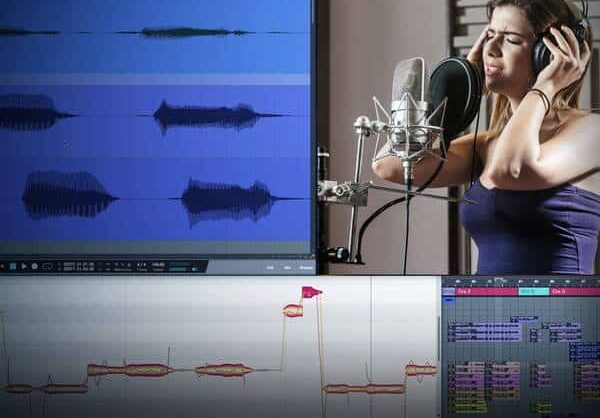
When it comes to capturing vocal nuances, there are a few things you should certainly consider, such as the vocals of a specific artist.
Every single artist you work with has a distinct:
- Vocal texture
- Pitch range
- Projection
While one microphone might excel at picking up the deep baritones of a male rapper, it might not do justice to the higher pitches of a female vocalist.
For instance, condenser microphones, with their sensitivity and frequency response, are often preferred for capturing detailed vocals in controlled studio environments.
#2. Instruments Have Their Own Voice
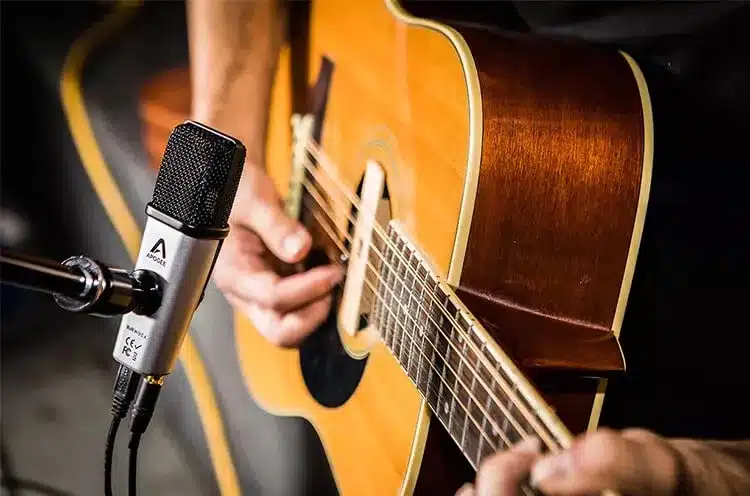
Just like vocals, instruments have their own unique voice too, so to speak.
The resonating sound of a grand piano, the strum of an acoustic guitar, or the bass-heavy thump of a kick drum 一 each instrument needs a specific microphone type.
For example, a dynamic microphone, known for its durability and ability to handle loud sound sources, is often the go-to for miking guitar amps and drums.
They capture the raw power of these instruments without any distortion.
#3. Room Acoustics Play a Role
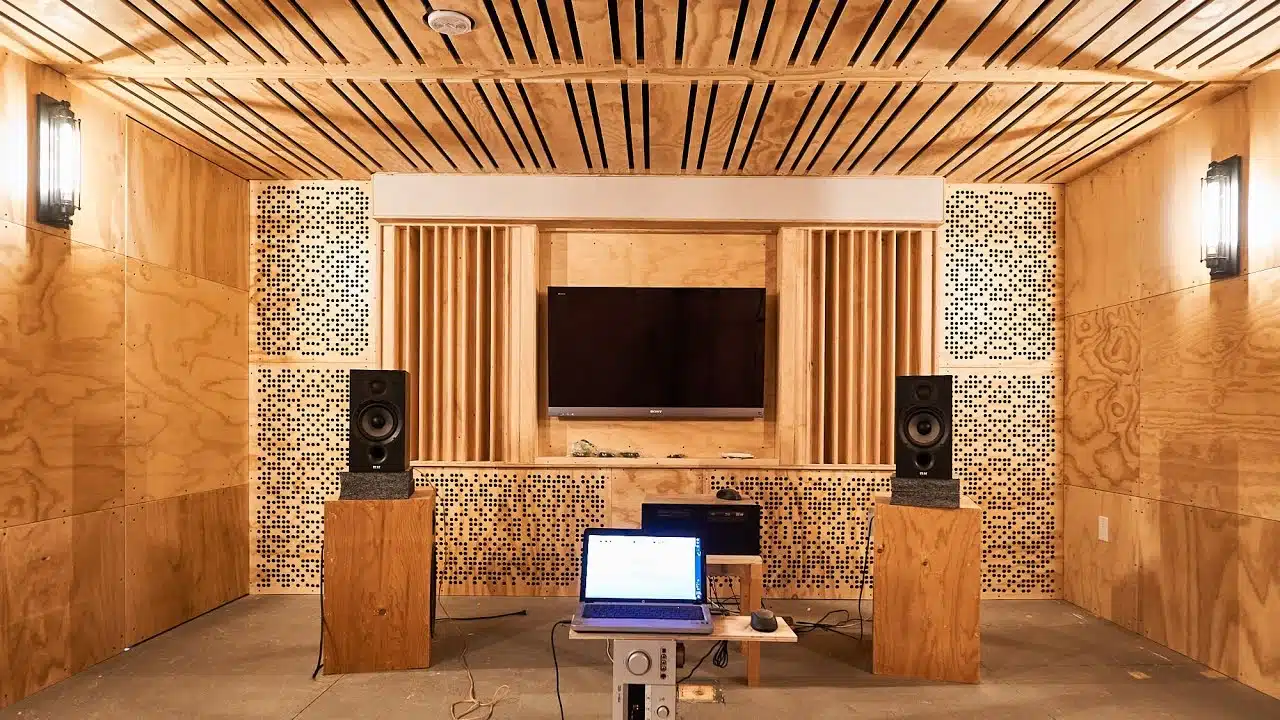
The environment where you record also influences your microphone choice.
While some microphones are designed to pick up sound from all directions (omnidirectional), others focus on capturing sound from a specific direction (cardioid or shotgun mics).
If you’re recording in a space with a lot of ambient noise, you’ll need a mic that can hone in on your sound source and reduce the background distractions.
#4. Versatility vs. Specialization

While some producers prefer to have a versatile microphone that’s a jack-of-all-trades, others invest in specialized mics tailored for specific tasks.
For example, ribbon microphones, known for their warm sound profile, are excellent for capturing the natural tones of vintage instruments or adding a retro flavor to vocals.
In essence, it’s not just about recording sound, but capturing:
- Emotion
- Energy
- Essence
That is where the right microphone types become invaluable.
And, as a music producer attempting to capture the most clear, professional recordings in the game, it’s vital to know all the different microphone types; so let’s get to it.
Condenser Microphones: The Producer’s Best Friend
Navigating the world of the different types of microphones, condenser microphones can be especially thrilling.
Often referred to as ‘capacitor mics,’ condenser microphones are renowned for their sensitivity and broad frequency response, particularly when sound waves hit their diaphragm.
So, let’s delve into why these the condenser mic is often a producer’s first choice.
-
Large Diaphragm Condenser Microphones
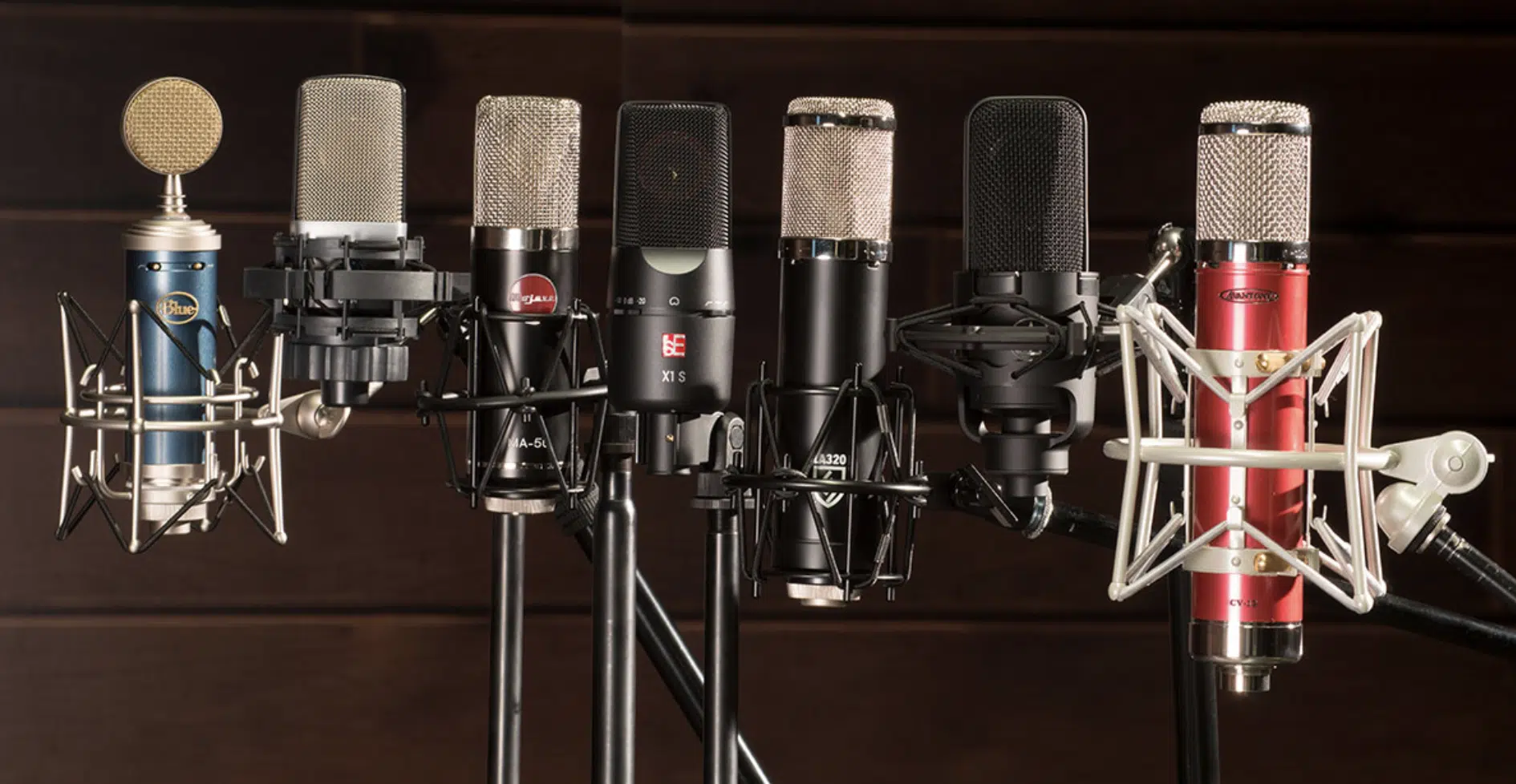
When music producers mention condenser microphones (condenser mics), they often refer to the large diaphragm variant.
Recognized for their wide frequency range, condenser mics are a staple in recording studios worldwide.
One of the key features of a large diaphragm condenser microphone is its ability to capture vocals with a richness and clarity that’s hard to beat.
Condenser microphones ensure every word is clear, such as when you’re:
- Laying down smooth R&B tracks
- Spitting rapid-fire hip hop verses
- Recording trap anthems for the ages
The design of condenser mics (specifically the larger diaphragm) makes them sensitive to sound waves 一 capturing even the subtlest nuances.
This is why large diaphragm condenser mics often the go-to for artists wanting to capture the raw emotions of their vocals.
However, with the level of sensitivity that a large diaphragm condenser mic brings to the table, it requires great care.
Therefore, large diaphragm condensers are not the best choice for extremely loud sound sources, as they might distort.
But for vocals, acoustic instruments, and soft to moderate sound levels, large diaphragm mics unparalleled.
NOTE: Two popular condenser microphone (condenser mic) choices among producers include the Neumann U87 and AKG C414.
Both of these large diaphragm condenser microphones offer incredible sound quality and ensure that your recordings have a very professional edge.
-
Small Diaphragm Condenser Microphones
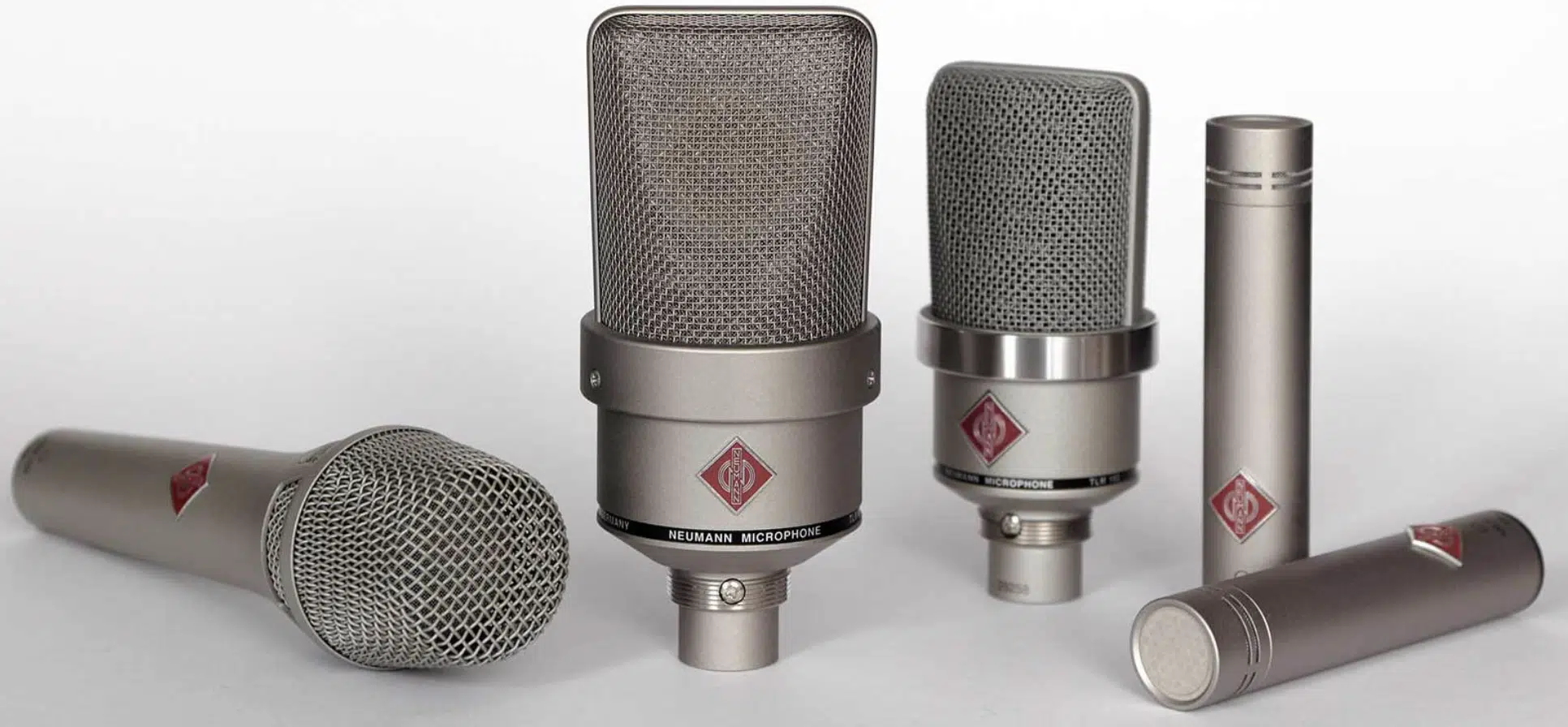
While their larger counterparts often steal the limelight, small diaphragm condenser microphones (often referred to as ‘pencil mics’) pack a punch.
A small diaphragm condenser mic is known for its precise, detailed sound.
In particular, small diaphragm condenser microphones excel in capturing the intricacies of acoustic instruments.
Small diaphragm condenser mics are ideal for ensuring every detail is present and accounted for, like the:
- Delicate plucking of a classical guitar
- Shimmering resonance of a cymbal
- Intricate timbres of a violin
Their design is geared towards a tighter polar pattern, allowing for focused sound capture.
This makes small diaphragm condenser microphones perfect for situations where ambient noise rejection is essential (such as in live sound environments) or when capturing instruments in ensemble settings.
Due to their size and design, small diaphragm mics are often chosen for stereo recording techniques, such as X-Y or ORTF configurations.
For example, the renowned Shure SM81 or the Sennheiser MKH 40 are often used in pairs to create stereo recordings that give a lifelike representation of acoustic spaces or ensembles.
NOTE: While their precision is commendable, a small diaphragm condenser mic might not always be the first choice for vocals.
The inherent character of large diaphragm microphones often suits the human voice better.
However, in certain scenarios, especially when a natural and uncolored representation is sought, these ‘pencil mics’ (small diaphragm condensers) can be the perfect choice.
-
Recording Vocals & Acoustic Instruments

Condenser microphones, both large and small diaphragm, stand out as the gold standard for recording vocals and acoustic instruments.
Their sensitivity and wide frequency response ensure that the full tonal range of a performance is captured.
For vocals, the clarity and detail offered by a condenser microphone, like the revered Neumann U87, can make sure a singer’s voice sounds phenomenal and shines in a mix.
From the airy highs to the resonant lows, every nuance is faithfully reproduced.
When recording acoustic instruments, capturing the instrument’s natural resonance and overtones is crucial.
For instance, the strings of an acoustic guitar or body of a cello have complex vibrations that give the instrument its character.
A condenser microphone (such as the AKG C451) can capture these nuances beautifully.
Plus, the transient response of condenser microphones is unparalleled.
In recording scenarios where the rapid start and stop of sound waves, such as with percussion instruments or a plucked string, need to be captured accurately, condenser microphones are the go-to.
Not to mention, in a professional studio setting, a well-chosen condenser microphone can elevate a recording from amateur to professional.
This makes condenser mics a vital tool for serious music producers and audio engineers.
Dynamic Microphones: The All-Around Mic
When it comes to durability and versatility, dynamic microphones stand at the forefront.
Recognized for their ability to handle high sound pressure levels and rough use, dynamic mics are a staple in many professional settings.
-
Introduction to Dynamic Mics & Their Versatility
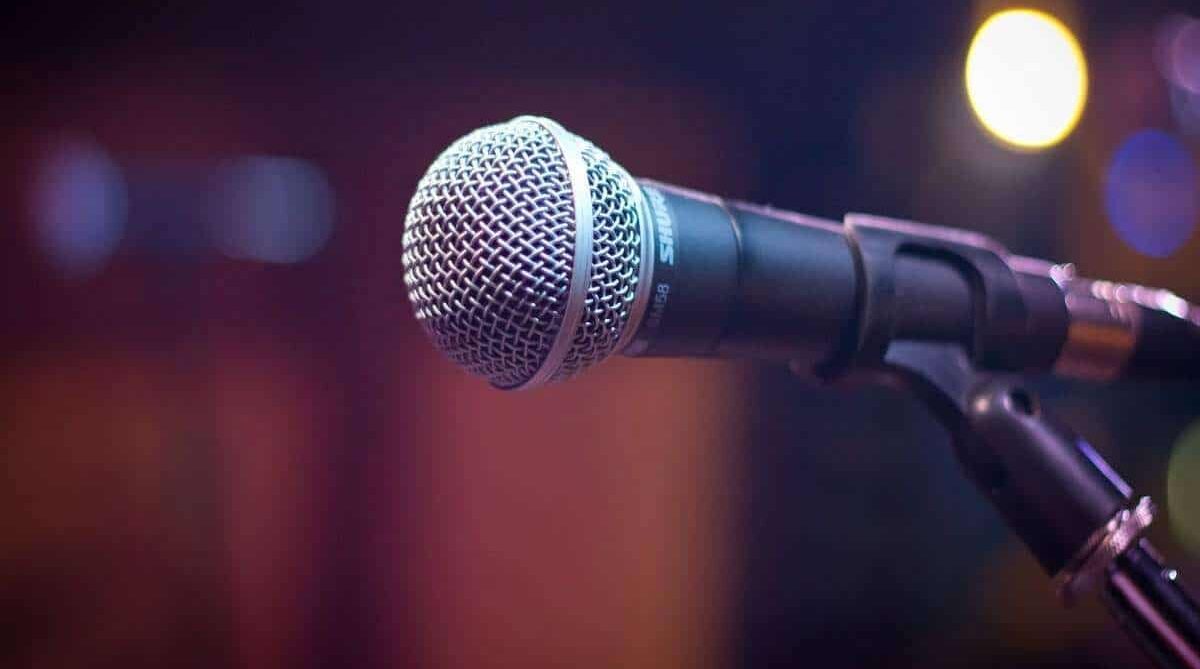
Dynamic microphones operate on the electromagnetic induction principle.
Essentially, a diaphragm/voice coil magnet assembly moves within the microphone, generating an electrical current.
This simplicity in design contributes to the dynamic microphones’ robustness and reliability.
Famed for their ability to withstand high sound pressure levels (SPL), dynamic microphones are commonly found in live sound scenarios.
Whether it’s on stage with roaring guitar amps or a vocalist belting out high notes, dynamic mics, such as the iconic Shure SM58, are up to the task.
The durability of a dynamic microphone extends beyond just handling loud sounds…
The physical design of many dynamic mics is rugged 一 making them suitable for touring where gear is frequently loaded and unloaded, facing potential drops and rough handling.
Despite their sturdiness, dynamic microphones offer a warm and smooth sound signature.
NOTE: While a dynamic mic may lack the detailed highs of condenser mics, this can often be beneficial, especially when trying to avoid harshness or excessive ambient noise.
Another advantage of dynamic microphones is their lack of need for an external power source; unlike condenser microphones.
This plug-and-play nature, combined with their robust build, makes condenser microphones a favorite for on-the-go recording and live sound.
-
Perfect for Capturing Loud Sound Sources (Like Guitar Amps)
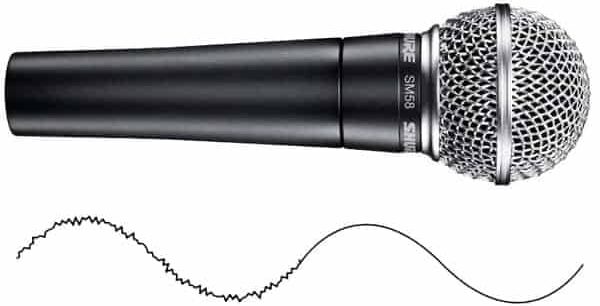
Guitar amplifiers, especially when driven to high volumes, emit a significant SPL.
Dynamic microphones (like the Shure SM57) have become the industry standard for capturing the roar of these particular amps.
The reason lies not just in their SPL handling but also in their frequency response.
The roll-off in the high frequencies can prevent overly bright or harsh tones 一 preserving the warmth and richness of a guitar sound.
The positioning of the dynamic mic in relation to the speaker cone can drastically alter their tonal quality.
These specific positions of a dynamic microphone include:
- Center
- Edge
- Off-axis
This flexibility allows sound engineers and producers to tailor the sound to their preferences using just one dynamic mic.
Similarly, drum kits, known for their explosive transients and volume, which technically makes them ‘loud instruments,’ are often miked with dynamics (a dynamic microphone).
A top-pick dynamic mic, like the Audix D6 for kick drums or the Sennheiser MD 421 for toms, can ensure that the power of the kit is captured without distortion.
So, if you’re a producer thriving for the most pristine recordings and epic mixes, dynamic microphones can be your best friend.
Ribbon Microphones: The Delicate Touch
A return to vintage charm meets contemporary demand in the world of ribbon microphones.
Ribbon mics, with their unparalleled warmth and intricacies, provide an alternative sonic character, so let’s get into it.
-
Frequency Range & Warmth of Ribbon Mics
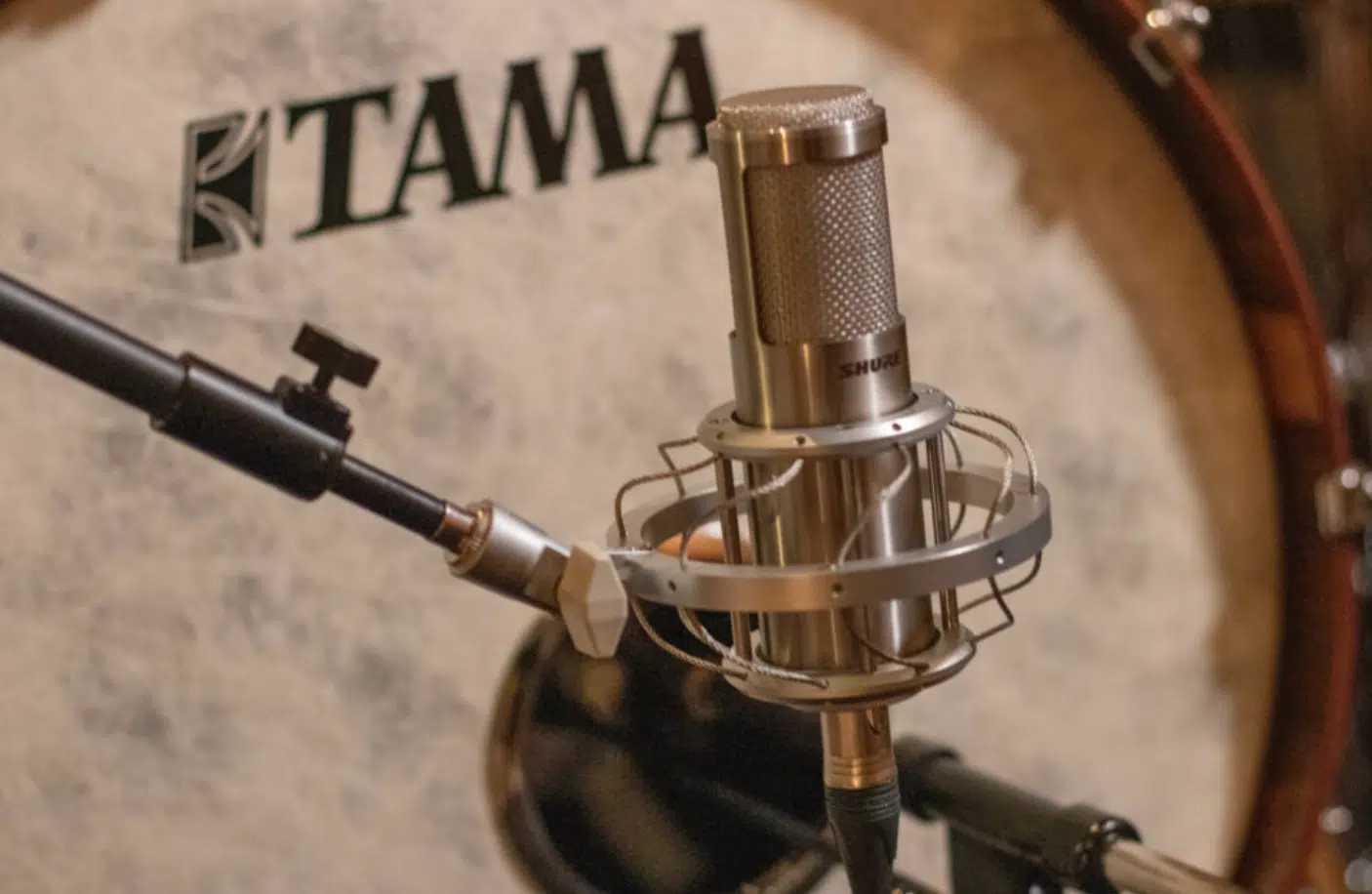
Ribbon microphones employ a thin metal ribbon suspended between the poles of a magnet, which produces voltage through electromagnetic induction.
This design results in a naturally smooth, vintage character that can soften even the most abrasive sound sources.
The frequency response of a Ribbon mic often showcases:
- A smooth roll-off in the highs 一 Preventing harshness.
- A robust mid-range 一 Lending body and warmth to recordings.
Instruments like brass, which can sometimes sound piercing, benefit immensely from the gentler touch of a ribbon mic.
The Royer R-121 Ribbon microphone is a notable example that has found its place in many home studios.
It’s prized for its ability to capture the nuances of guitar amplifiers 一 imparting a velvety smoothness that’s difficult to achieve with other mic types.
One unique characteristic of many ribbon microphones is their figure-8 polar pattern.
This means ribbon microphones are capable of capturing sound equally from the front and back, which can be leveraged for some creative recording techniques, such as Blumlein stereo.
NOTE: The sonic wonders provided by a Ribbon microphone comes with a cautionary note; it is super delicate.
The thin ribbon can easily be damaged by strong gusts of air or high SPLs, necessitating careful handling, so be very careful when dealing with types of microphones like this one.
-
Why Ribbon Microphones are an Asset in Any Studio
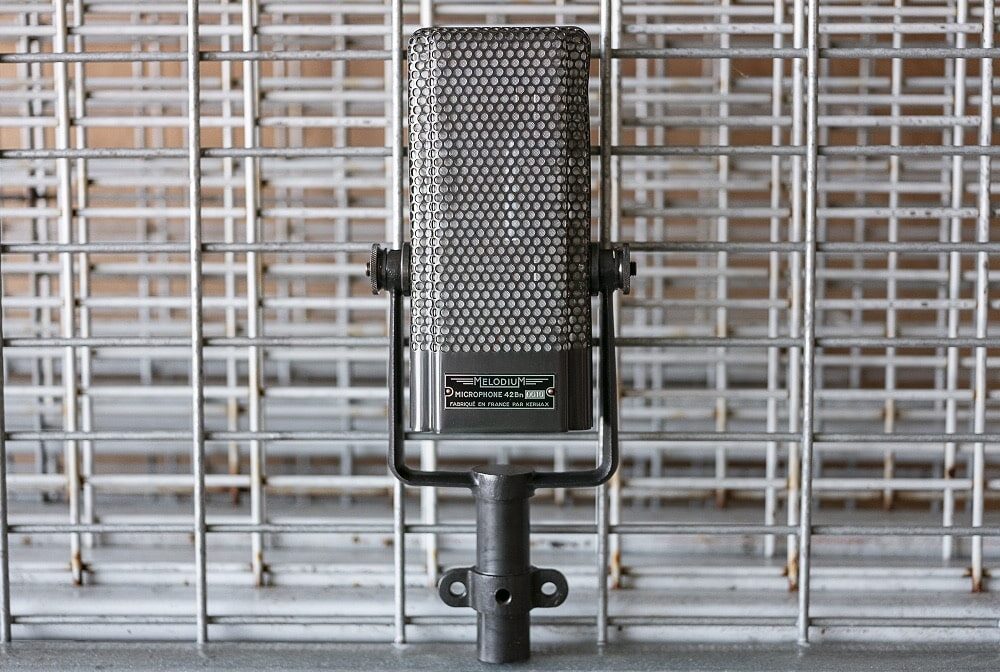
Their unique sonic character alone sets ribbon microphones apart.
In a world where digital recordings can sometimes feel sterile or overly bright, the warmth of a ribbon microphone can reintroduce a sense of organic authenticity.
Beyond just sound character, ribbon mics provide versatility in capturing room ambience (thanks to their typical figure-8 pattern).
They can be invaluable in capturing the vibe of a room or the natural reverb of a space.
Ribbon mics’ blending capabilities are also noteworthy.
When recording ensembles or groups, a Ribbon mic can be strategically placed to blend various instruments together 一 creating a cohesive and balanced sound.
However, it’s essential to know how and when to use them.
For sources with extreme transients or very high SPLs, other mics might be more suitable.
Still, for the right application, ribbon mics are irreplaceable.
NOTE: Phantom power, typically beneficial for condenser microphones, can be the doom of certain vintage or unbalanced ribbon mics.
Always ensure compatibility before engaging phantom power.
Cardioid Mics: Directional Mastery
The cardioid microphone, named after its heart-shaped pickup pattern, specializes in honing in on sound from a specific direction while rejecting sounds from the sides and rear.
-
The Cardioid Pattern & its Benefits
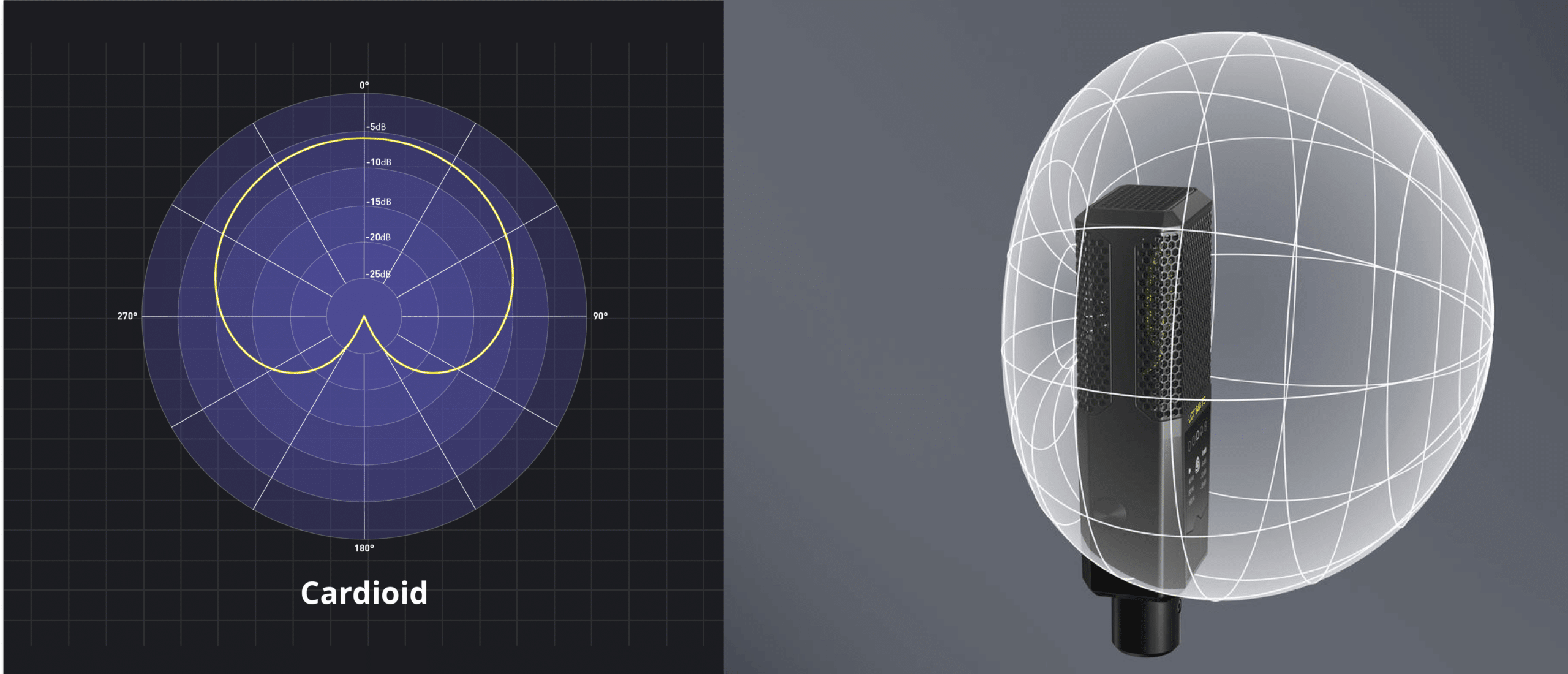
The cardioid pattern is the most common directional pattern found in microphones.
Its ability to focus on sound coming from in front of it while rejecting ambient noise from the sides and back makes it highly versatile and suitable for a variety of recording situations.
This pattern is particularly useful in live settings; where onstage monitors or unwanted noise from the audience might interfere with the desired sound.
It ensures that the microphone picks up primarily the intended source.
Another advantage is the reduced feedback.
Since feedback often originates from speakers positioned to the sides or behind the microphone, the cardioid’s rejection capabilities are invaluable in preventing it.
The effectiveness of the cardioid pattern, however, can vary based on the microphone’s design and quality (especially the cardioid dynamic mic).
Some may offer a tighter or broader cardioid pattern 一 while others can veer slightly towards super-cardioid or hyper-cardioid patterns.
-
The Difference Between Cardioid Mics & Other Types of Microphones
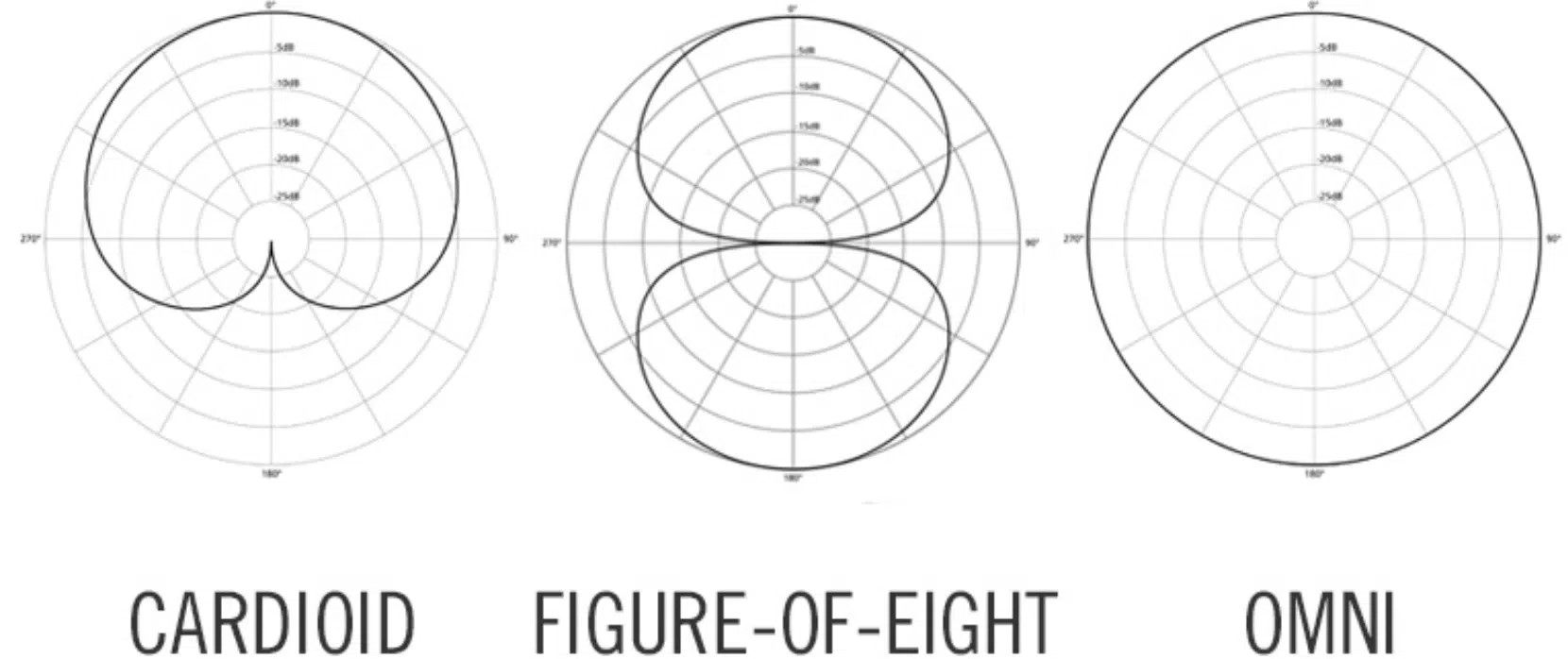
While the cardioid pattern is a polar pattern, not a microphone type, it is most commonly associated with both dynamic and condenser microphones.
However, what differentiates cardioid microphones from other types of microphones, like omnidirectional microphones or figure-8 microphones, is their directionality.
Omnidirectional mics capture sound equally from all directions 一 making them more prone to room noise and less suited for isolated sound sources.
Figure-8 mics capture sound from both the front and back but reject sounds from the sides.
Cardioid mics, given their focus, are the go-to for situations requiring sound isolation.
From podcasting to studio recordings where ambient noise rejection is crucial, their directional mastery shines.
It’s also worth noting that within the cardioid family, variations like supercardioid and hypercardioid offer even tighter front-focused patterns but with slight rear sensitivity.
Knowing the intricacies of different types of microphones is the first step to creating pristine tracks and choosing the right mic for your specific needs.
USB Microphones: Modern Convenience for Producers
In an age of rapid digital evolution, USB microphones bridge the gap between traditional recording and the demands of modern producers.
A USB condenser mic provides both amateur and seasoned creators with a plug-and-play option.
These types of microphones are actually growing popularity very quickly, so it’s essential to learn all about them.
-
The Rise of USB Microphones in Home Studios
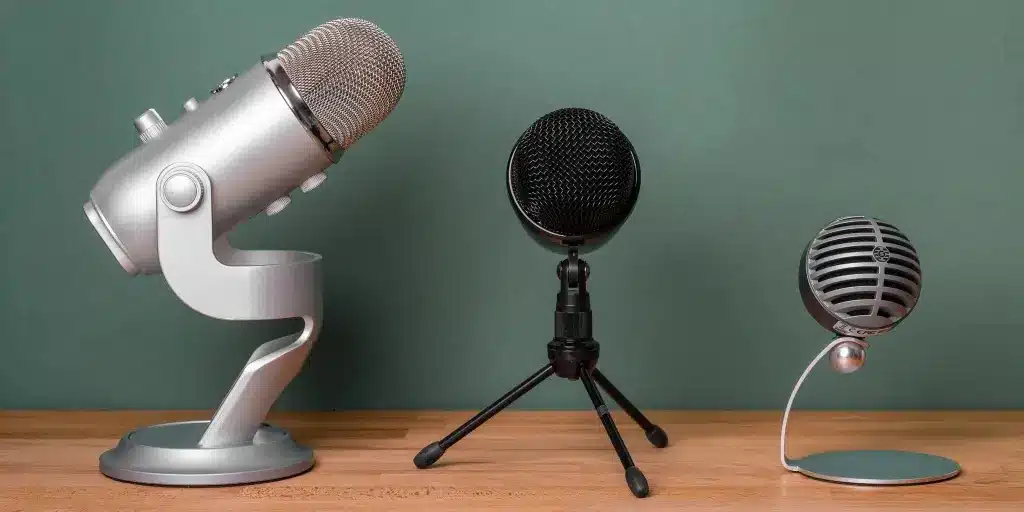
The proliferation of home studios, podcasts, and streaming platforms has seen a corresponding rise in the popularity of USB microphones.
The simplicity of connecting a microphone directly to a computer without the need for additional audio interfaces or equipment is a major draw.
For amateur producers or content creators just starting out, the USB microphone offers an affordable and efficient entry point.
NOTE: Popular modern USB mics, like Blue with their Yeti and Snowball microphones have become household names due to this surge.
Plus, with advancements in technology, USB microphones are not just limited to basic applications.
Many now offer:
- Multiple polar patterns
- On-mic controls
- Even built-in headphone outputs for real-time monitoring
However, it’s not just the beginners benefiting from a USB mic…
Seasoned professionals often opt for USB mics for their convenience during travel, or as a quick go-to for rough drafts and idea capture.
While the rise of USB mics is evident, it’s crucial to understand their working mechanism and how they may differ from the traditional XLR counterparts.
-
How USB Mics Convert Sound Waves into an Audio Signal
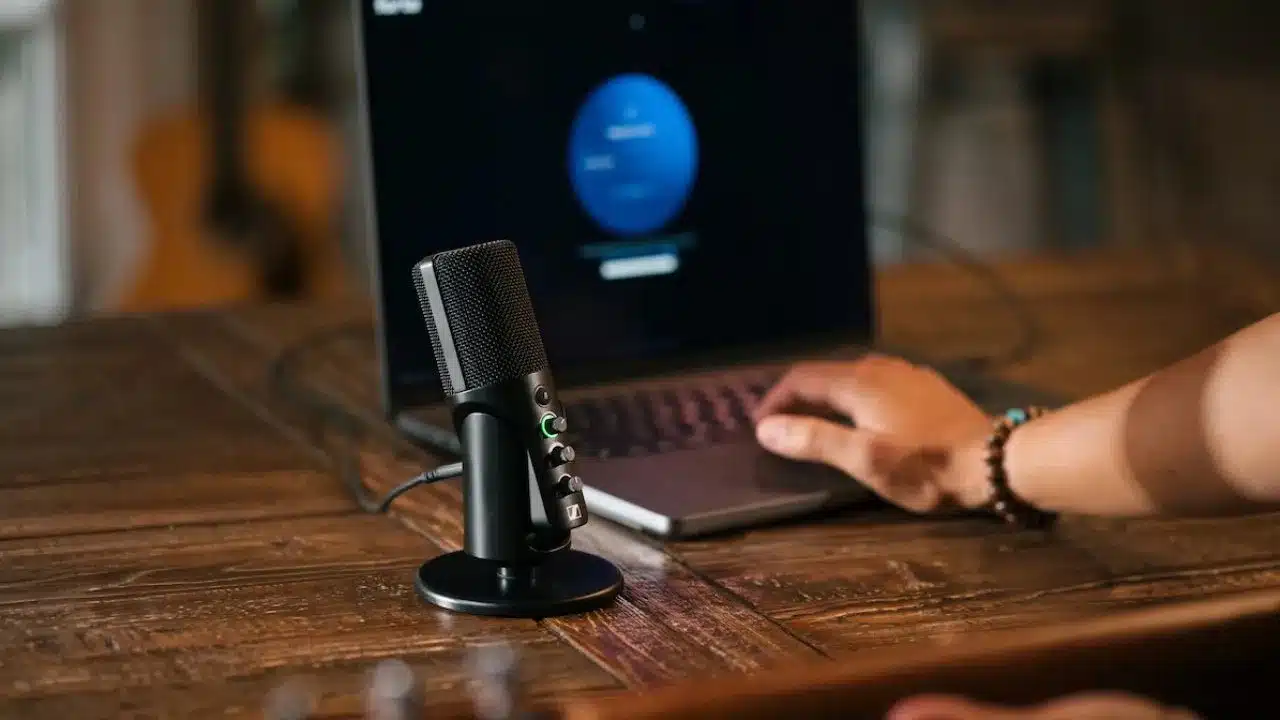
The fundamental process of converting acoustic sound waves into an electrical signal remains consistent across microphones.
What differentiates a USB microphone is the built-in analog-to-digital converter.
- A traditional microphone 一 Sends an analog signal to an audio interface, which then converts it to a digital signal for the computer.
- USB microphones 一 Streamline this by handling the conversion within the microphone itself.
This internal conversion, like most things, comes with its benefits and drawbacks.
The immediate advantage is the elimination of the need for separate audio interfaces or preamps.
However, this convenience may come at the cost of flexibility in sound shaping, as one is reliant on the microphone’s built-in preamp and converter quality.
Regardless, for many applications (especially voice-over work, podcasting, or basic recording), the quality of modern USB microphones suffices and sometimes even excels.
Specialty Mics for Unique Needs
The world of microphones goes beyond just the usual ‘best microphone’ options.
For particular applications and unique recording scenarios, specialty microphones come into play 一 showcasing the broad spectrum of audio capture tools available.
-
Shotgun Mics
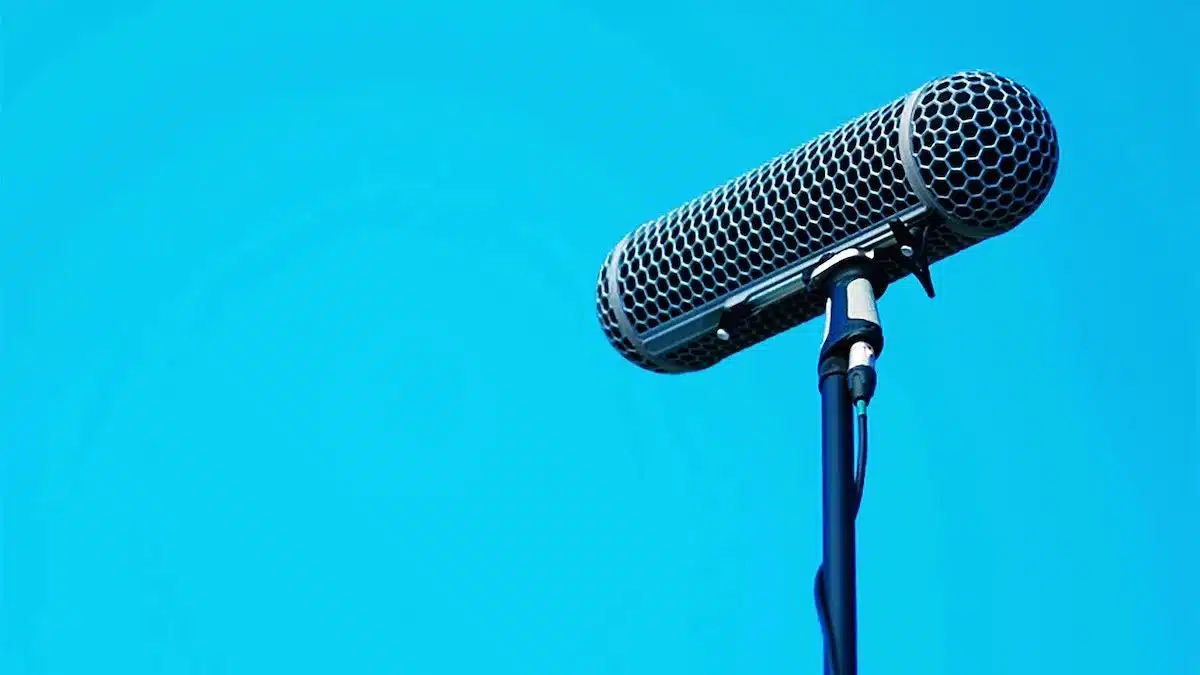
Shotgun microphones are a staple in film and broadcast, known for their ability to focus on a specific sound source.
Their narrow area of sensitivity, or polar pattern, allows them to pick up sound from a particular direction 一 minimizing ambient noise.
This precision makes a Shotgun mic ideal for situations where background noise needs to be minimized.
For instance, during on-location film shoots or live news broadcasts where extraneous sounds are abundant.
Shotgun mic brands, like Sennheiser and Rode, are renowned for their shotgun microphones.
The Sennheiser MKH 416, for example, has been a favorite in the film industry for its reliability and clear sound capture.
However, using shotgun mics requires skill.
Proper aiming at the sound source and understanding the mic’s pickup pattern are crucial to achieve the desired audio clarity.
-
Pencil Mics, Room Mics, and Bass Mics
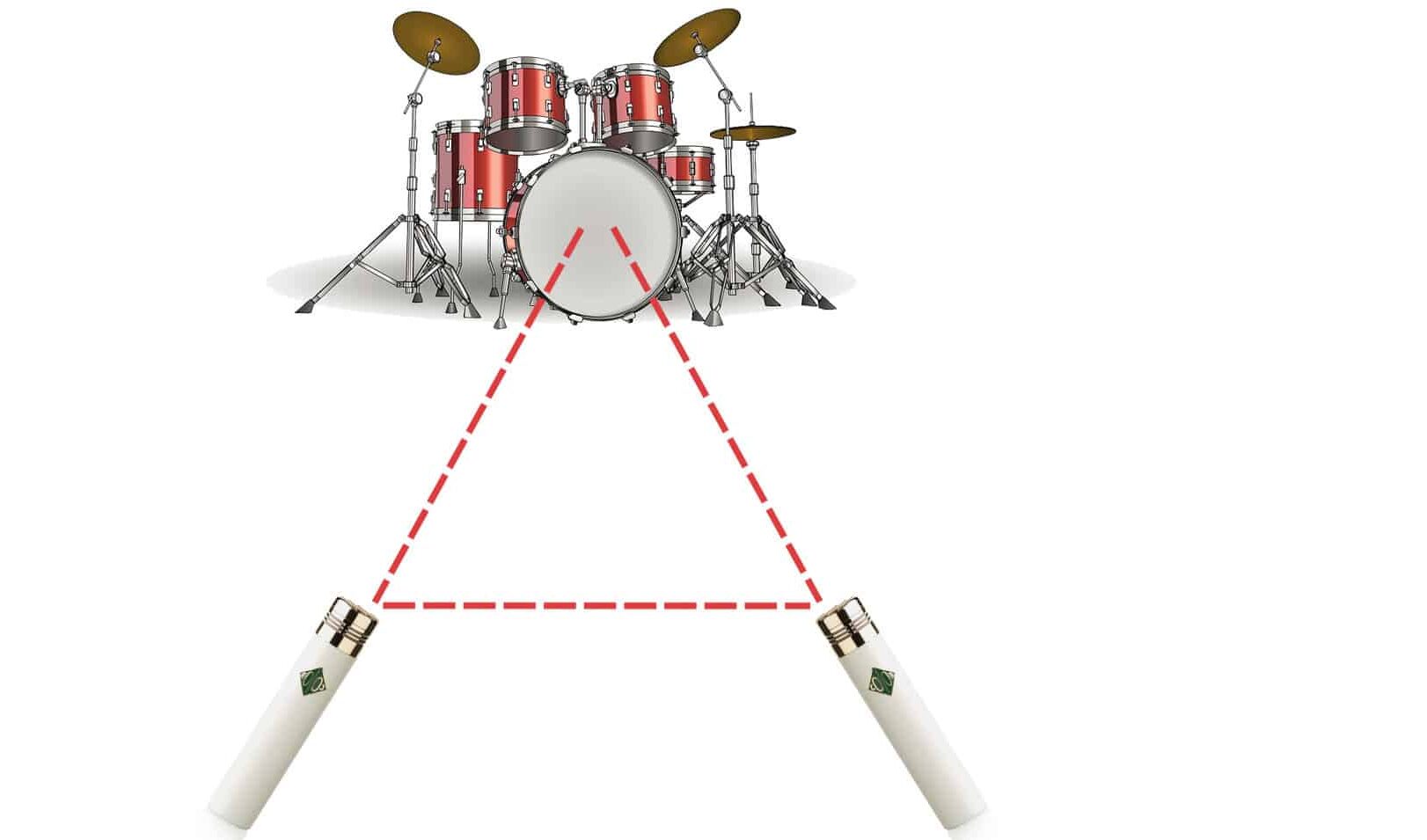
Pencil microphones (often small-diaphragm condensers, as we discussed) are prized for their accurate sound reproduction.
This is especially true when capturing the nuances of acoustic instruments like cymbals or strings.
Room microphones, on the other hand, are strategically placed to capture the ambience and natural reverb of a space 一 adding depth and dimension to recordings.
Bass microphones are engineered to capture low-frequency sounds with clarity.
A Bass mic is often employed to mic kick drums or bass cabinets, ensuring that the lower end of a mix remains punchy and well-defined.
Each of these specialty mics, from brands like Neumann, AKG, and Shure, serve a specific purpose in the studio.
They can help you achieve a certain sound or feel in their recordings.
-
Wireless Microphones
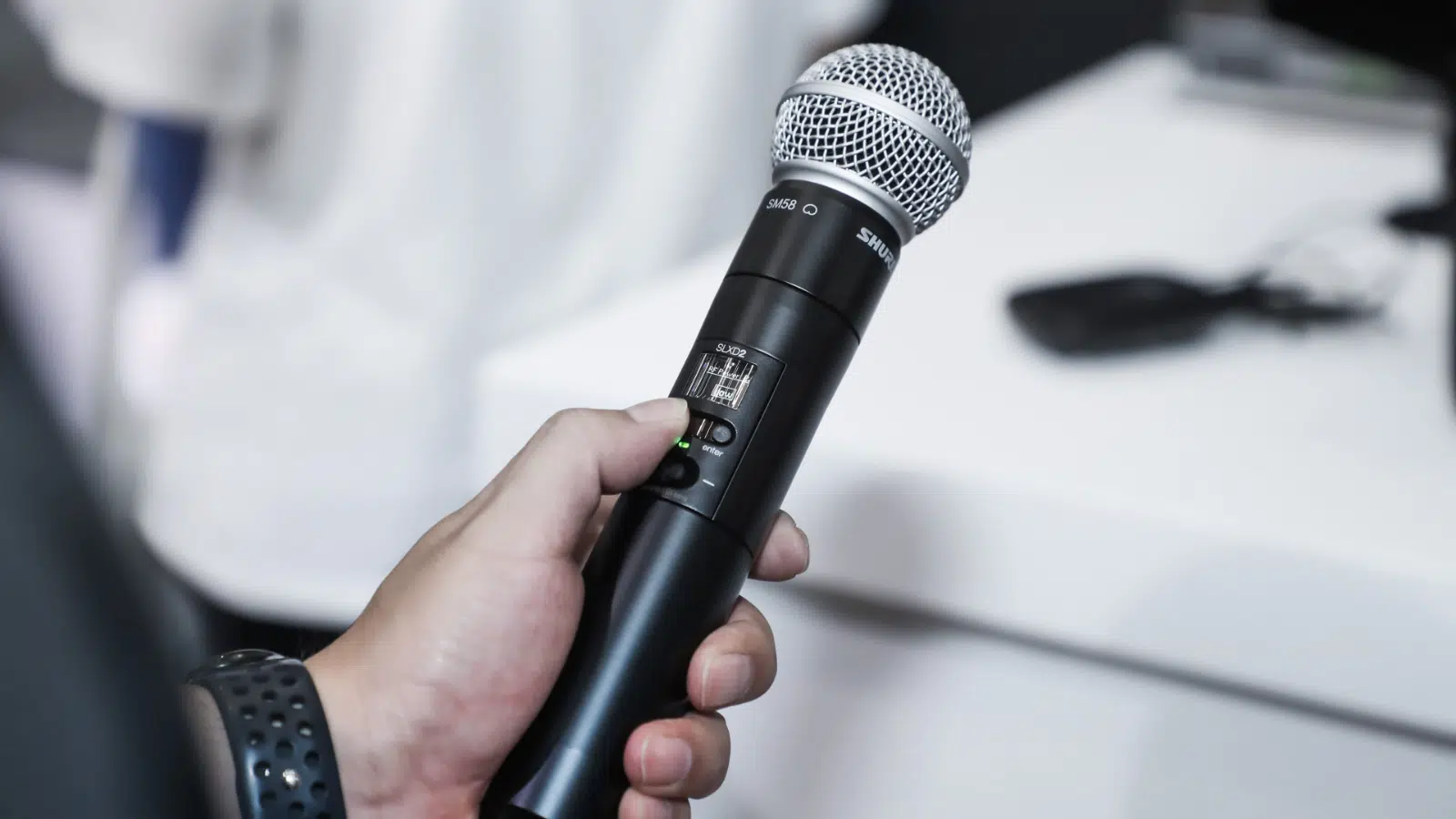
The evolution of audio tech has also ushered in reliable wireless microphone systems.
Perfect for live performances or scenarios requiring mobility, they eliminate the constraints posed by cables.
Leading brands in this space (such as Shure and Sennheiser) have wireless systems that deliver clear, interference-free audio.
Yes, even in challenging environments packed with potential radio frequency interference.
Besides the stage, wireless mics find utility in dynamic recording scenarios, such as:
- Capturing a moving subject.
- Dealing with complex setups where cable management could become an issue.
However, it’s essential to note that, while convenient, wireless systems require more maintenance, like regular battery replacements.
This means it may not always offer the same fidelity as their wired counterparts.
Techniques & Tricks for the Best Sound
Achieving the best sound is an art, blending technical know-how with creative flair.
Knowing your equipment and the recording environment, coupled with a few tricks of the trade, can significantly elevate the quality of your recordings.
-
How to Control Ambient Noise for the Cleanest Recordings
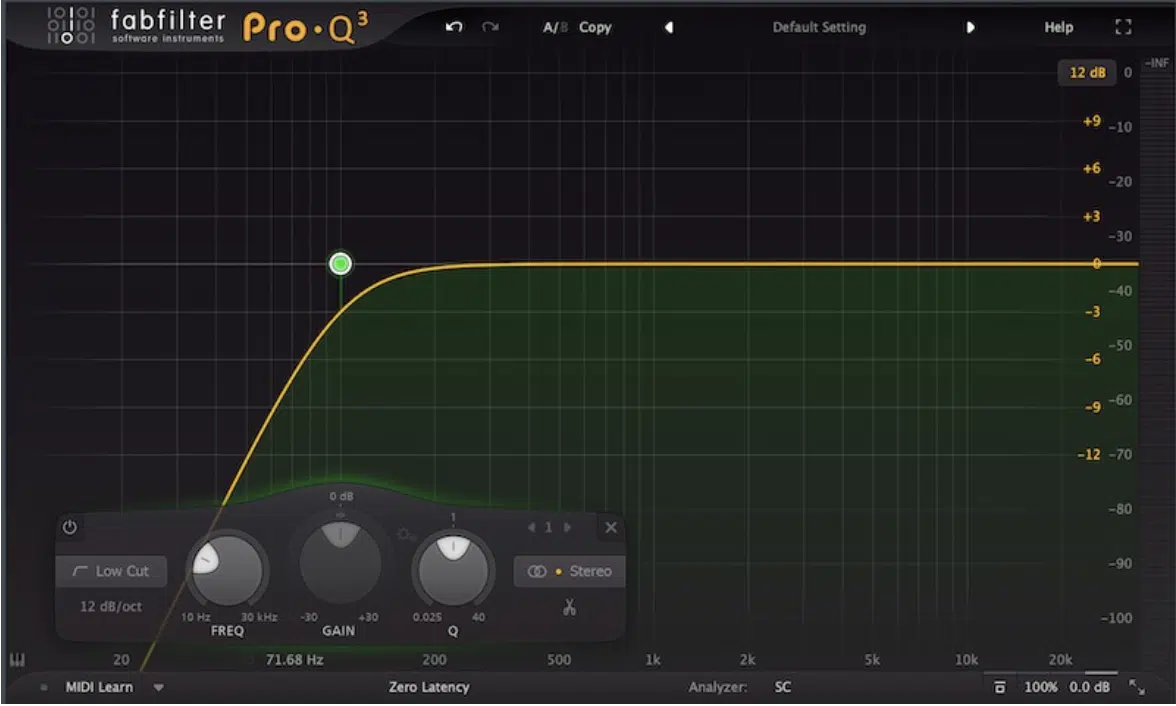
Ambient noise can be the destruction of any recording session.
From the hum of an air conditioner to the distant murmur of traffic, unwanted sounds can compromise audio quality in a detrimental way.
#1. Soundproofing the recording environment is crucial.
This can be done using bass traps, diffusers, and acoustic panels. These tools absorb or scatter sound waves, minimizing reflections and external noises.
#2. Strategic mic placement plays a pivotal role.
For instance, positioning a microphone closer to the source can help in capturing a more direct sound, reducing the influence of ambient noises.
#3. Using High-pass Filters
High-pass filters, available in many microphones and audio interfaces, can also be employed to cut out low-frequency rumbles that might be present due to distant traffic or machinery.
#4. Post-production Tools
Post-production tools, like noise gates or software plugins, such as iZotope’s RX, can be invaluable in cleaning up recordings, removing errant noises and ensuring a clean, clear sound.
If you implement these professional tips and tricks, you’ll soon master all the different types of microphones and produce the cleanest tracks around.
-
Stereo Recording Techniques with Different Types of Microphones
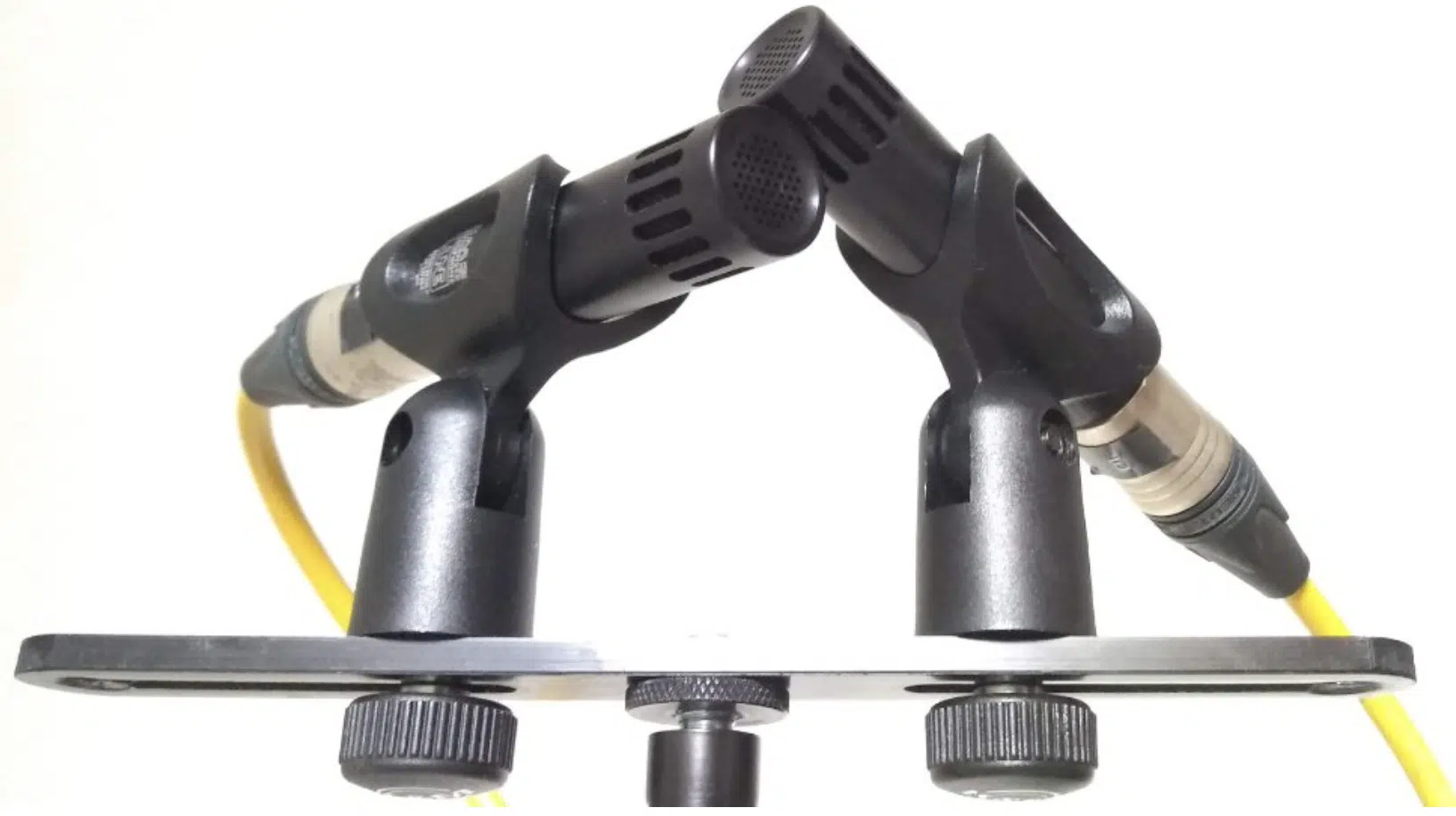
Now let’s dive into not only how to choose the right mic for your intended purpose, but how different microphone types can help you achieve musical greatness.
Stereo recording, capturing two separate audio channels to convey a sense of space, depth, and directionality, adds dimension to your sound.
Different techniques can be used depending on the desired spatial effect and the subject being recorded.
The X-Y technique employs two cardioid mics placed with their capsules as close together as possible (at angles between 90 to 120 degrees).
This provides a well-defined stereo image that is suitable for elements like an acoustic guitar or choir.
ORTF (Office de Radiodiffusion Télévision Française) is another popular method.
It uses two cardioid mics:
- Spaced 17 cm apart
- Angled outward at 110 degrees
ORTF is renowned for capturing a more natural stereo image of orchestras or ambient soundscapes.
The Mid-Side (M-S) technique utilizes a cardioid mic (mid) and a bidirectional mic (side).
In post-production, the side channel is duplicated, with one channel phase-reversed 一 when combined, it offers flexibility in widening or narrowing the stereo image in post-production.
Binaural recording, though niche, uses two omnidirectional mics placed in or around a human-like ear structure, replicating human hearing.
This provides a 3D audio experience, especially evident when listening through headphones.
-
Pairing the Right Audio Interface for Your Microphone Types
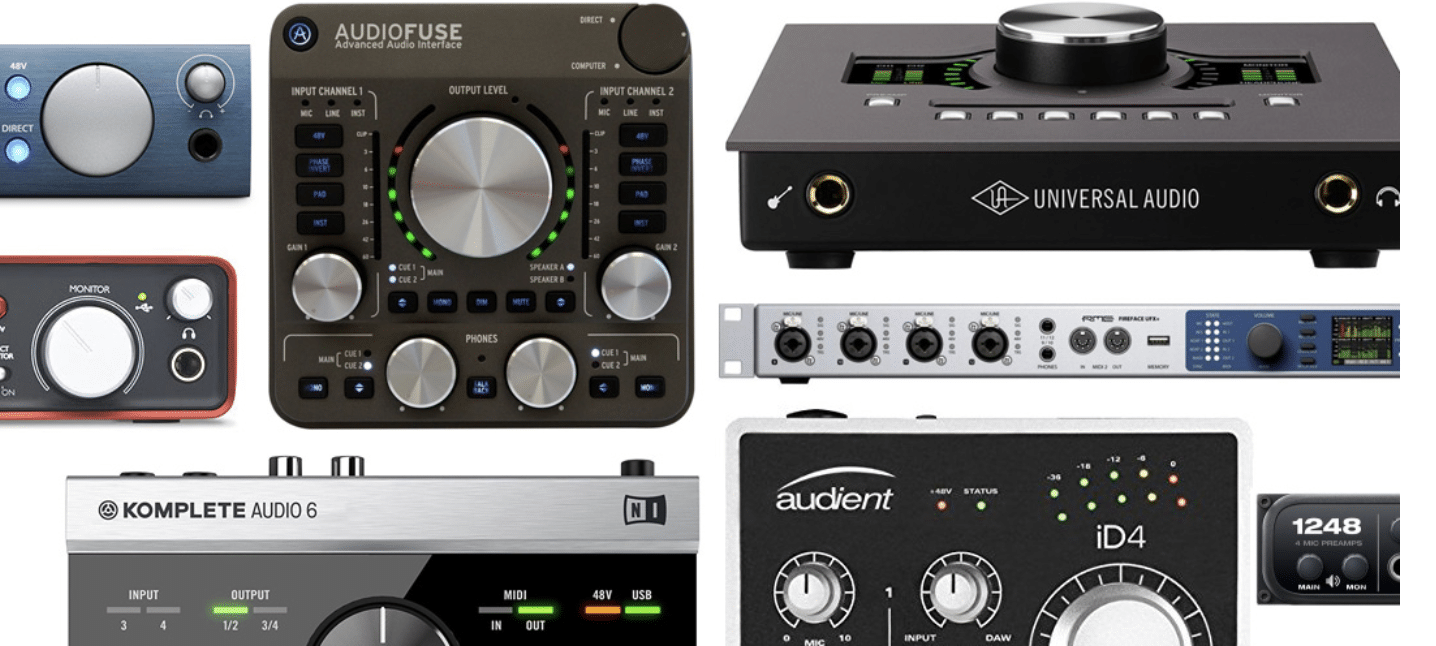
An audio interface acts as a bridge between microphones and computers, converting the analog signal from the mic into a digital format the computer can process.
The right pairing can profoundly influence sound quality.
For condenser microphones, an interface that supplies phantom power is imperative.
NOTE: Brands like Focusrite, Universal Audio, and PreSonus offer interfaces with premium preamps that bring out the best in these microphones.
Side note, if you’d like to learn all about the best audio interfaces in the game, we’ve got you covered.
Dynamic mics, while less demanding, still benefit from a high-quality interface, as a good preamp can make a significant difference in:
- Clarity
- Headroom
- Warmth
For those into digital production, USB microphones bypass the need for a separate audio interface.
Still, for more extensive studio setups, interfaces with multiple inputs, MIDI capabilities, and high-resolution audio are more appropriate.
Lastly, always consider the connectivity of the interface.
USB-C, Thunderbolt, and PCIe all offer different data rates and compatibility options.
The objective is seamless integration with your workflow 一 ensuring that the microphone and interface communicate effectively.
Types of Microphones: Final Thoughts
The types of microphones you choose to employ can make or break the sound quality of your recordings.
Each of the different types of microphones we’ve discussed has its own set of strengths tailored for specific recording scenarios.
From capturing the subtle details in a vocalist’s performance with condenser mics to handling the booming sounds of a live drum set with dynamic mics, understanding the nuances of each is crucial.
Selecting the appropriate types of microphones for each recording task ensures clarity and a professional edge to your mixes.
And remember, even with the best types of microphones, the raw vocal quality is equally important.
Once you’ve honed in on your preferred microphone type and technique, you should integrate high-quality vocal samples into your mix.
For the most pristine vocals around, you should download these completely Free Vocal Samples.
It contains 20 professional-quality vocal loops, chops, and one-shots.
These samples are crafted in the same styles as today’s biggest hit songs 一 ensuring that your production, combined with the right types of microphones, will have a current and polished sound.
While equipment, techniques, and samples play a significant role, the knowledge and application of the right types of microphones remain at the heart of a clear and top-tier recording.
So, once you absorb all the knowledge in this article, you’ll be well-equipped to create the most professional mixes with all the different types of microphones you have access to.
Until next time…







Leave a Reply
You must belogged in to post a comment.